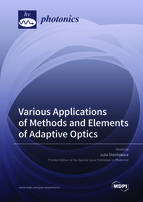Various Applications of Methods and Elements of Adaptive Optics
A special issue of Photonics (ISSN 2304-6732).
Deadline for manuscript submissions: closed (15 March 2022) | Viewed by 20078
Special Issue Editor
Special Issue Information
Dear Colleagues,
Advances in the field of adaptive optics have produced an expanding toolkit for a growing number of photonics applications, including laser beam propagation, signal processing, vision science, astronomy, and other areas. Innovation in laser adaptive optics is a key to solving various scientific and technological problems, from improving the performance of laser systems to enabling new applications. This Special Issue is focused on a wide range of topics, including but not limited to the following:
- Adaptive optic components and tools;
- Wavefront sensing;
- Control algorithms;
- Beam shaping and control;
- Imaging;
- Astronomy;
- Optical communications;
- Propagation through turbulent and turbid media.
Dr. Julia Sheldakova
Guest Editor
Manuscript Submission Information
Manuscripts should be submitted online at www.mdpi.com by registering and logging in to this website. Once you are registered, click here to go to the submission form. Manuscripts can be submitted until the deadline. All submissions that pass pre-check are peer-reviewed. Accepted papers will be published continuously in the journal (as soon as accepted) and will be listed together on the special issue website. Research articles, review articles as well as short communications are invited. For planned papers, a title and short abstract (about 100 words) can be sent to the Editorial Office for announcement on this website.
Submitted manuscripts should not have been published previously, nor be under consideration for publication elsewhere (except conference proceedings papers). All manuscripts are thoroughly refereed through a single-blind peer-review process. A guide for authors and other relevant information for submission of manuscripts is available on the Instructions for Authors page. Photonics is an international peer-reviewed open access monthly journal published by MDPI.
Please visit the Instructions for Authors page before submitting a manuscript. The Article Processing Charge (APC) for publication in this open access journal is 2400 CHF (Swiss Francs). Submitted papers should be well formatted and use good English. Authors may use MDPI's English editing service prior to publication or during author revisions.
Keywords
- Adaptive optic components and tools
- Wavefront sensing
- Control algorithms
- Beam shaping and control
- Imaging
- Astronomy
- Optical communications
- Propagation through turbulent and turbid media






